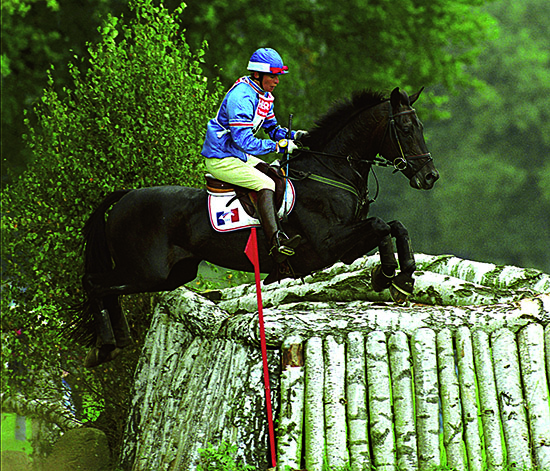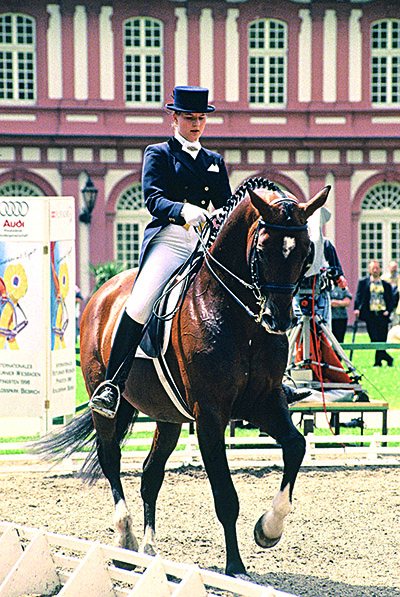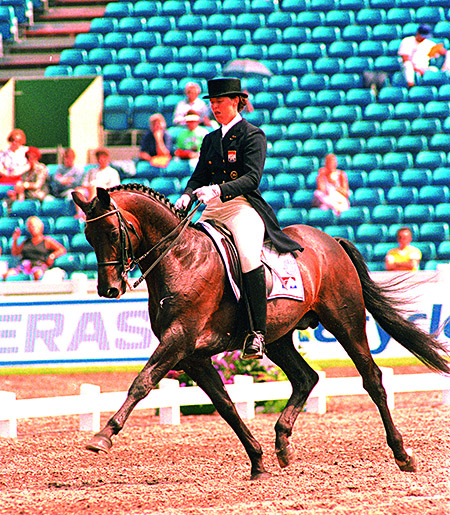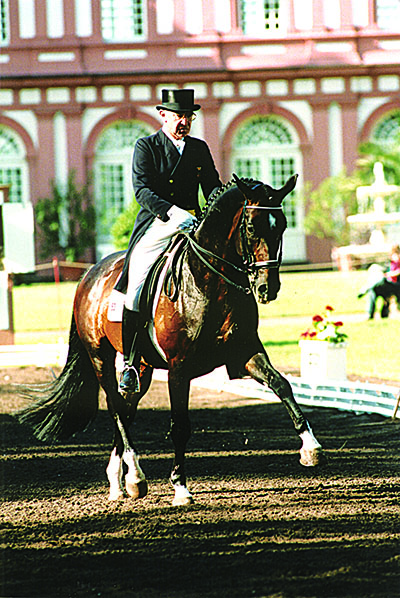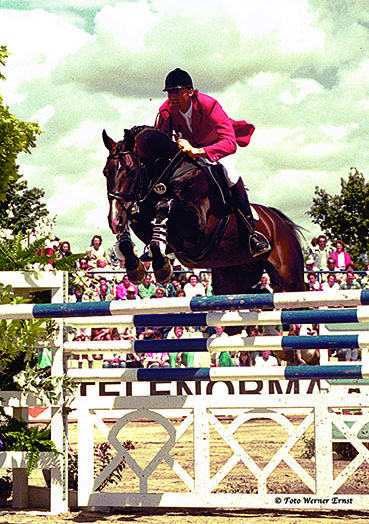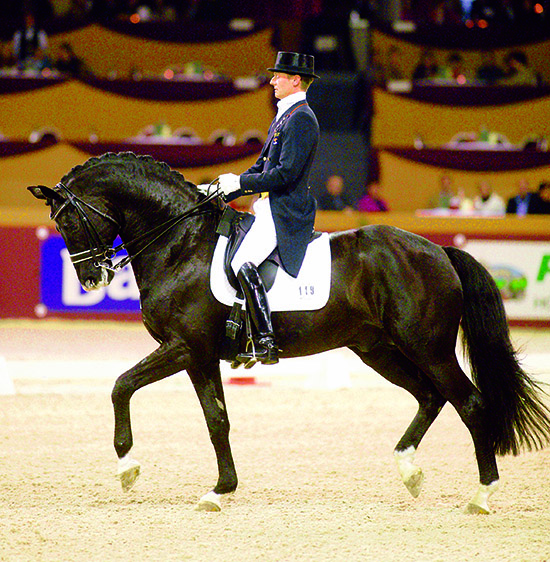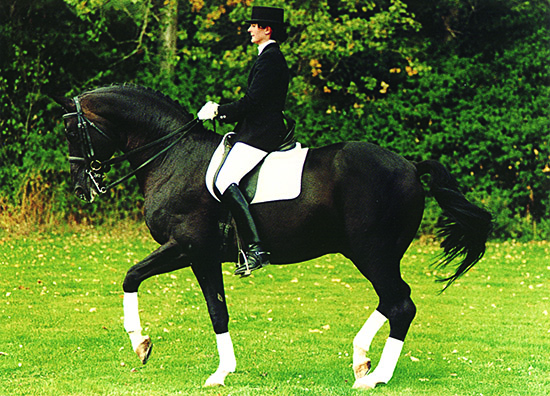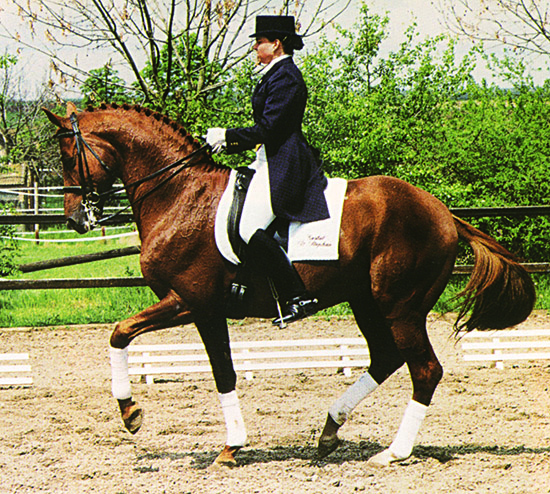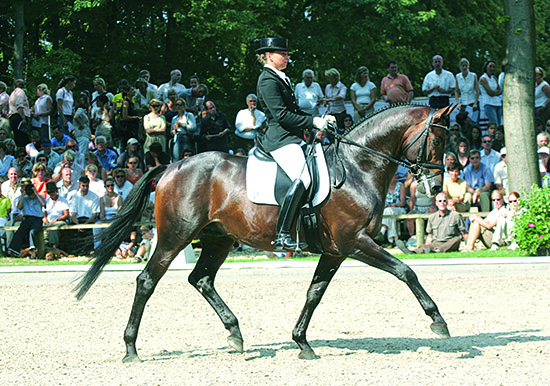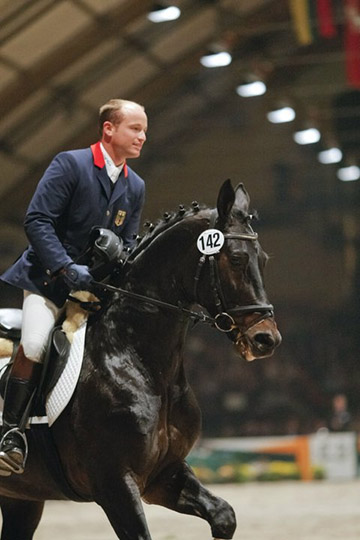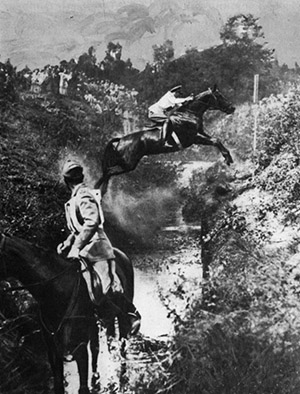 Above Left: The 1936 Eventing double gold medallist, Nurmi with Captain Stubbendorff; Right: A more modern eventing Trakehner, White Girl with Peter Thomsen
Above Left: The 1936 Eventing double gold medallist, Nurmi with Captain Stubbendorff; Right: A more modern eventing Trakehner, White Girl with Peter Thomsen
Ten years ago, our German breeding expert, Jan Tönjes charted the resurgence of interest in the Trakehner breed… It was in the 90’s that the bad reputation of Trakehner horses as poor perfomers changed. Slowly but continuously the number of horses doing well increased. Especially in dressage and eventing.
Ten years later, Jan’s words are even more relevant…
White Girl TSF, a grey mare by the Anglo Arab, Bajar made it to the German eventing team. Ridden by Peter Thomsen, White Girl was one of the first horses to carry the TSF suffix that stands for Trakehner Sportpferde Foerderung, a club designed to support Trakehner horses in sport and to bring together promising young horses and good riders at an early stage. A concept that went well. At the European Champs in 1993 White Girl TSF was the best horse in the German team and in 1994 they were part of the bronze winning team at the World Equestrian Games at The Hague. White Girl was retired after the 1996 Olympic Games in Atlanta.
There were more eventers with the elk horn brand successful in the 1990’s. Summersong by Fleetwater Opposition – himself in CCI*** successful and for more than a decade the leading sire in the UK for producing eventers – was the perfect mount for French Marie-Christine Duroy. And the Kiwis who did so well in eventing had Jaegermeister II by Polarschnee (a Trakehner stallion, who was imported to Australia in the 1980s) with Andrew Nicholson in the Bronze winning team in Atlanta.
Summersong – such a star for the French rider, Marie-Christine Duroy
In Germany the star of Windfall started to rise when Ingrid Klimke qualified him in dressage and eventing for the Bundeschampionate. His sire, Grand Prix by Swazi xx (TB) had already taken Ingrid to a couple of high placings in CCI***. Marina Koehncke competed her own Boettcher’s Longchamps by Sir Shostakovich xx at the WEG in Rome but the pair tragically took a wrong way in the cross country. Sir Shostakovich a Thoroughbred also used a lot in the Holstein breed is sire of a couple of strong eventers. Sir Shostakovich has the most amazing concentration of classic Thoroughbred jumping blood on his pedigree with up close crosses of Precipitation (x 2), Grey Sovereign, Blue Peter and half a dozen Bay Ronald representatives.
While the number of competitors in international top events was comparatively high – one always has to keep in mind that not more than 1000 – 1200 Trakehner foals are born each year, the reputation in Germany still did not reflect the change. Ask a German – Trakehners are still a synonym for spooky horses that are not easy to train.
It is the Bundeschampionate, this meeting of the best young prospects the German Warmblood breeds are able to present, that helped the Trakehner breed to recover the other breeds’ respect.
Trakehners were always in the ribbons and a couple of the former champions are on their way to reach FEI level. Kunta Kinte TSF and Peter Thomsen participated at the World Young Eventing Horse Championships in Lion d’Angers and were placed in CCI***s. It was also Thomsen who rode Vilano by Consul at the WEG in Jerez 2002. Like all the other German competitors the pair’s perfomance wasn’t of the kind to get a place in the hall of fame, but the bay gelding was selected and made it to fence 14 in the cross country course that caused so many discussions.
Talking about the 21st century you need to mention Gelha’s Seacookie, though only seven years old in 2006, this bay gelding is considered a true international prospect in Ingrid Klimke’s stables. Ingrid found him in the autumn of 2003 as an unbroken four-year-old, started to train him in the winter and won the Bundeschampionate 2004.
Stallions in the dressage ring
Back to the Olympics of Atlanta. Hardly any other Warmblood breed has had nearly as many licensed stallions compete at FEI-level in dressage and actually do well! The picture perfect example in the mid 90’s was Peron TSF by Mahagoni. After the stallion approval, the typey bay was exported to the USA, and no-one really thought any more about him. But then a little American girl was standing at Rudolf Zeilinger’s barn, knocking heavily on the door. This is how a trainer/rider partnership started that finally was awarded with the team Bronze medal and a 5th place individually for Michelle Gibson.
Peron – the Trakehner that starred for the USA
Peron TSF then continued his career with Rudoph Zeilinger and was actually considered a hopeful for the European championships. The stallion kept on competing after being sold to Switzerland but suddenly died. In breeding his influence wasn’t as big as expected. In a way Peron was always a charming but long horse with a weak back whose extensions were never the highlight of the test. His passage and piaffe movements however, especially the transitions, counted as the best to be seen in the ring at the time.
Heuriger by Herzbube is named an elite stallion, a title only awarded to a small number of stallions with successfull progeny. 1994 was definitely the year of this nice bay. As well as taking out team Silver at the 1994 WEG in Den Haag, where Heuriger helped Ellen Bontje to gain an individual 5th place, Heuriger was named world’s most successful dressage stallion – taking into consideration that Donnerhall was part of the German team that year, one may get an impression of how important Heuriger was for his breed.
Heuriger, starring at the WEG at The Hague
As said before in the first part of this treatise on Trakehner horses, history, in particular German history to be precise, is a major influence on breeding policy. Like no other breed in Germany the Trakehner association took a benefit from the end of the iron curtain. With the Berlin Wall coming down in 1989, the Trakehner breed got the chance to use genes based on the old Trakehner lines from the main stud in East Prussia that had gone through a different development.
The Trakehner horses that were bred in former East Germany (GDR) showed a remarkable jumping talent. And stallions from Russia or the Baltic states have played an important role ever since then. Almox Prints by legendary Prussian sire Hockey took part at the 1988 Seoul Olympics and the 1992 Games in Barcelona. He also won the Grand Prix of Rotterdam and Wiesbaden and a small number of breeders took the chance to get outcross genes and jumping ability.
More attention was paid to Biotop, the last Grand Prix horse of the late Dr Reiner Klimke, Germany’s most successful equestrian athlete of all times. The gorgeous mover is 21 years in 2006 and was shown in hand on the big stallion show in Muenster-Handorf, early in February. The crowd was fascinated. Still so powerful and not at all looking old, Biotop, whose dam is by Hockey, already sired Shakira who in 2003 was named German champion mare. So far two of his sons, Goldschmidt and Monte Castello, are licensed.
Anky van Grunsven’s TCN Partout by Arogno is another dressage stallion with international wins. He never really was able to get close to Bonfire’s performances but won World Cup qualifiers. His son Monteverdi, in training with Danish Fie Skarsoe, was selected champion stallion and following his sire’s example is aiming for international fame. For a while it seemed a Trakehner horse – Renaissance Fleur TSF – was about to grab one of the prestigious places in Germany’s dressage team, something all breeding associations dream of! A perfect horse for advertisements, Renaissance Fleur TSF by Tuareg and Monica Theodorescu seemed to be on the right way but then, only two days after winning the Neumuenster World Cup qualifier 2003 the grey mare broke her leg.
If there’s a horse right now that may fill out the gap Renaissance Fleur TSF left, it is Tannenhof’s Solero TSF. Again a licensed stallion and one with a typical German career. He is ridden by Anja Ploenzke whose stud Tannenhof is located some 45 minutes from Frankfurt international airport. Solero was third in the Nuernberger Burgpokals finals. In 2005 Ploenzke was third in the German lady championships and she topped her splendid season with winning the World Cup qualifier in Frankfurt with Solero in December 2005. Ploenzke is ambitious. Her goal is to join the A-squad and possibly make it to the WEG 2006 Aachen.
The Russians are COMING! Biotop and Dr Reiner Klimke
Almox Prints and Elmar Gundel
Talking about stallions in the international dressage circus the name Gribaldi needs to be mentioned first. Before the licensing the black Kostolany colt was purchased by Dutch stallion keeper, Joep van Uytert. The minute the black was chosen champion stallion a huge promotion campaign took off. Wherever you are in Europe – Sweden, the UK, Norway, Switzerland, Belgium – if you ask breeders about popular Trakehner dressage stallions they will answer Gribaldi. Dozens of his progeny made it to the World Championships of Young Dressage horses. Painted Black, Anky’s up and coming Grand Prix horse, runner up at the World Championships (only beaten by the fabulous Poetin) is also a son of Gribaldi. Edward Gal has many international top placings at prestigious shows with Gribaldi.
Edward Gal and Gribaldi
As a colt Gribaldi was discovered by Otto Langels of Haemelschenburg stud. Langels is well known for his breeding policy that doesn’t necessarily go hand in hand with what is in vogue at the moment. Himself a Grand Prix rider Langels was never fond of the small handsome and beautiful Trakehners so popular in the 70’s and 80’s. Horses bred at his farm are mostly not so refined.
Gribaldi’s sire, Kostolany
And Kostolany, Gribaldi’s sire, is no exception from this rule. The black was champion stallion in 1987 and owes a lot of his popularity not only to his offspring that shows various talents (GP dressage horses, eventers and 1.50m showjumpers) but to the fact that Langels performed the equine version of the Phantom of the Opera to the music of Andrew Lloyd Webber, Kostolany would not only do piaffes and passages but also sit and lay down. When the show was first presented at the Equitana the audience was thrilled. In the past 20 years Kostolany has covered more mares from the Trakehner breeding programme than any other sire. Via different sons he is grandsire to two champion stallions, Farinelli and Freudenfest.
Gribaldi’s best offspring in Germany is Hofrat, runner up at the 2000 grading and sire of the 2005 Hannoverian champion stallion Hotline (out of a De Niro dam). This gorgeous dark bay is of a different kind. His movements are outstanding, his willingness to work unbelievable. When Paul Schockemöhle and Danish premier stud Blue Hors decided to join and bid 800.000 Euro for Hotline, Germany’s horseworld was turned upside down. 800.000 Euro – unbelievable! In February Hotline was shown the first time under saddle. Even experienced breeders couldn’t believe their eyes. Totally relaxed with maximum activity from behind, the Hannoverian champion took his laps. The people in the stands were so thrilled that they forgot to applaud!
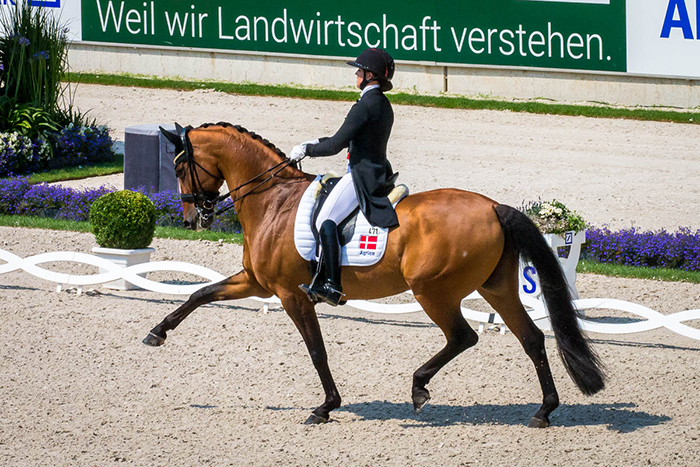
Vamos Amigos, Cathrine Dufour’s latest star, out of a mare by Hotline
Of course the Trakehners are also proud of Hotline because they always see the improvement of Warmblood breeds as part of their breeding philosophy. And if Paul Schockemöhle, who never made a secret out of his general distaste for Trakehner horses, buys such a horse, than the Trakehners must have changed.
Van Deyk – too good to be used…
Two years older than Kostolany is Van Deyk by Patricius xx (TB). In past years, the chestnut had as few as three mares a season, but his influence on the Trakehner breed is getting more and more important. His two spectacular sons Kaiserkult TSF and Kaiserdom TSF, full brothers out of elite mare Kimora by Gajus, won the Bundeschampionate for 6-year-old Dressage Horses for the past two years in a row!
Kaiserkult like his sire Van Deyk was in training with the Schneider family right from the very beginning. Van Deyk was actually bred by Hans Eduard Schneider whose daughter Dorothee started her career with Van Deyk. Both went to elementary school and learned together until they attended university. Van Deyk never won a Grand Prix but runner up on several occasions even at international shows.The Schneiders who used to live in Wiesbaden, home of the international event held each year on Whitsunday, knew right from the beginning that Van Deyk, a chestnut standing at 16.2 hands was something special.
“This horse from the very first moment said: here I am! There wasn’t a single moment in is entire career where one may be in doubt about his outstanding personality,” says Hans Eduard Schneider. Van Deyk’s offspring share a lot of similarities: “They are all fighters. In a positive way of course. They fight for their riders. But of course you need to be able to ride such a horse. They are full of character. And that’s why so many of them made it to the top.”
Character is one thing but if you want to point out an outstanding feature to be found with all of Van Deyk’s progeny, it is the canter. In opposite to most of the Trakehner horses with their flat front leg canter that looks more like skating than like cantering Van Deyk’s offspring are always round.
This is true for the brothers Kaiserkult and Kaiserdom who is in training with Kathrin Meyer zu Strohen, wife of German junior riders team coach Hans-Heinrich, who had the ride of her life when winning the World Championships with the Brandenburg mare Poetin.
Kaiserkault at the Bundeschampionate
Kaisedrdom is so well balanced and eager to work, that Meyer zu Strohen was already able to present three times tempis to the crowd at the stallion show in Münster. It seems like his elder brother Kaiserkult, Kaiserdom as a 7-year-old will also be able to score 70% or even higher in Prix St Georges tests.
Grand Prix is no problem for theses horses. Sachsenkoenig by Handryk (by Van Deyk) already belonged to the team that won the Nation’s Cup at the CDI Saumur. This chestnut is shown by Kathrin Bettenworth, Germany’s champion of professional dressage riders.
Another son of Van Deyk who again went to elementary school at the Schneider’s Gestuet St Stephan is Polarion. The graded stallion was Trakehner champion as a 6-year-old and won four Prix St Georges as a 7-year-old. The dressage world started that certain kind of whisper that is always good for a horse that is for sale. “Have you heard about this Trakehner stallion? Is it true what they say about his talent for passage and piaffe?”
It didn’t take too long until British dressage enthusiast, Dr Wilfried Bechtolsheimer heard about Polarion and as in most of the cases when the enthusiastic supporter of his daughter Laura has heard of a good horse for sale, the sale went through. Polarion went to the Bechtolsheimer’s facility in England and after two successful seasons in the small tour Laura made her Grand Prix debut aboard Polarion.
Now Laura’s trainer Markus Gribbe has the ride, since Laura took over her father’s Douglas Dorsey. In 2005 became Britain’s youngest dressage champion ever. The student of philosophy and politics – both important things for a dressage rider as Laura says with a broad smile in her face and a little girlish blush – is concentrating on the WEG 2006 and Gribbe, a fomer German B-squad rider, is lucky to compete Polarion.
The year Polarion left Germany, his first son was licensed. Grafenstolz a big bay with lots of frame and a canter like a Holstein. The premium stallion was bought by the Birkhof stud, one of the most influentuial studfarms in southern Germany, an hour away from Stuttgart. There was a moment of hesitation before Thomas Casper, owner of Birkhof stud, signed the contract. Would a Trakehner be accepted by the local breeders? Would a Trakehner cause enough attraction among Germany’s breeders – of course the Birkhof is operating not only Germany wide but has contacts with many other European breeds e.g. in Switzerland, Ireland, France and Belgium? Being sure that Grafenstolz was the stallion to clear all the prejudices against Trakehner horses, Casper agreed to the deal.
Grafenstolz and Michael Jung…
Three years later, when Grafenstolz’s first crop was highly praised in Baden Wurttemberg and the average score of the foals was even better than those of French Kiss – who was on his way that later led to the win of the World Championships of Young Dressage horses.
Ridden by triple European Young rider eventing champion Michael Jung, Grafenstolz, now Birkhof’s Grafenstolz TSF to be precise, qualified for the Bundeschampionate in all three disciplines, dressage, showjumping and eventing. He won the eventing with a historic 95%. The way he galloped through the course was just astonishing. A month later Grafenstolz also won the World Championship in Lion d’Angers. As a six-year-old, this eventer already performed very nice 3 and 2 tempis! So if dressage is getting even more important in eventing Grafenstolz doesn’t have to be scared.
As a 7-year-old he won a CCI*** and every now and then you hear the word “Beijing“ when insiders talk about Germany’s future eventing team and the combination Jung/ Grafenstolz.
Beijing or Hong Kong is only two years away but this year’s focus is definitely the WEG in Aachen. It is there that Caprimond will be retired. Caprimond is by far the most influential sire of the Arogno-line. Grand sire to Hannoverian champion stallion His Highness and grand-grandsire to the winner of the 2005 Trakehner grading Herzensdieb.




